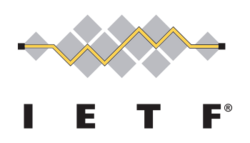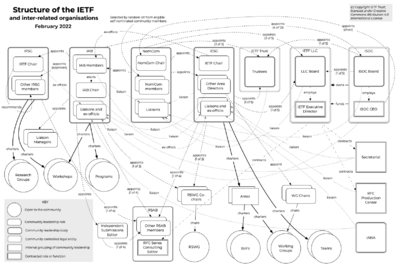Internet Engineering Task Force facts for kids
 |
|
| Abbreviation | IETF |
|---|---|
| Formation | January 1986 |
| Type |
|
| Purpose | Creating voluntary standards to maintain and improve the usability and interoperability of the Internet |
|
Parent organization
|
Internet Society |
| Internet history timeline |
|
Early research and development:
Merging the networks and creating the Internet:
Commercialization, privatization, broader access leads to the modern Internet:
Examples of Internet services:
|
The Internet Engineering Task Force (IETF) is a group that creates important rules for the Internet. These rules are called technical standards. They help the Internet work smoothly for everyone. The IETF makes sure different parts of the Internet can talk to each other.
Anyone can join the IETF. There are no special requirements. All the people who work there are volunteers. Their work is often paid for by their employers. The IETF started with support from the US government. Since 1993, it has been part of the Internet Society. This is a group that helps the Internet grow worldwide.
Contents
How the IETF Works
The IETF does not have a formal membership list. Anyone can take part in its work. You can join a working group's email list. You can also sign up for an IETF meeting.
Developing Internet Standards
The IETF creates standards in an open way. Everyone can join in. You can become part of a "working group." Each group has leaders called co-chairs. They also have a plan for what they need to do. Discussions happen on open email lists. Working groups also meet in person.
Decisions are made by "rough consensus." This means most people agree. There are no formal votes. Each working group usually finishes its task and then closes. Sometimes, a group's plan is updated for new tasks.
Organizing the Work
Working groups are put into larger "areas." Each area has directors. These directors choose the working group leaders. The area directors and the IETF Chair form the Internet Engineering Steering Group (IESG). This group manages the IETF's daily work.
The Internet Architecture Board (IAB) helps the IETF with outside groups. The IAB also guides the Internet's future growth. It also manages the Internet Research Task Force (IRTF). The IETF and IRTF often work together.
A special committee called NomCom chooses leaders. This committee has volunteers who attend meetings often. They pick people for the IESG, IAB, and other IETF groups.
In 1993, the IETF became independent. It joined the Internet Society. The Internet Society is a non-profit group. In 2018, the Internet Society created a new company. This company, IETF Administration LLC, handles the IETF's business and legal needs. The IETF gets money from meeting fees and sponsors. It also gets money from the Internet Society.
In 2005, the IETF Trust was created. It manages the materials the IETF creates. These materials are protected by copyright.
The Steering Group (IESG)
The Internet Engineering Steering Group (IESG) is very important. It includes the IETF chair and area directors. This group reviews new Internet standards. It also manages the IETF's daily activities. The IESG makes final decisions on documents.
The IESG chair is also the overall IETF chair. The IESG has directors from different areas. These areas include:
- Applications and real-time (art)
- General (gen)
- Internet (int)
- Operations and management (ops)
- Routing (rtg)
- Security (sec)
- Web and Internet transport (wit)
Other members also join the IESG. These include the IETF executive director and the IAB chair.
History of Leadership
The IETF grew from an earlier group called GADS. The first IETF meeting was in January 1986. It had 21 researchers from the US government. Mike Corrigan was the first IETF chair.
In 1987, Phill Gross became the IETF chair. In 1989, a group called CNRI started helping the IETF. They provided support for its work.
In 1992, the Internet Society was formed. The IETF became a project of the Internet Society. This helped the IETF become more independent. In 1995, it was made clear that the Internet Society's role was only administrative. It had no say in the technical content of standards.
In 2018, the IETF Administration LLC was set up. This company now handles the IETF's administration.
IETF Meetings
The first IETF meeting was small. It had only 21 people. It took place on January 16, 1986. People from companies started joining meetings in October 1986. Since then, all IETF meetings have been open to the public.
At first, the IETF met four times a year. Since 1991, it has met three times a year. Early meetings were very small. Fewer than 35 people attended the first five meetings. The largest meeting had 2810 people in December 2000. Now, about 1200 people usually attend.
IETF meetings are held in different places. They try to meet where most volunteers live. Meetings happen once in Asia, once in Europe, and once in North America each year.
The IETF also holds "hackathons" during meetings. These events focus on writing code. This helps improve standards and make them work better together.
How the IETF Operates
The IETF's way of working has changed over time. But the main idea is still the same. They publish ideas for new standards. Then, people develop these ideas. Others review and test them. Finally, the ideas are published as Internet Standards.
Anyone interested can join this open process. All IETF documents are free to access online. They can be copied by anyone. For a standard to be approved, it must have many working examples. These examples must show that the standard works well.
The IETF works with other groups. These include the W3C, ISO/IEC, and ITU. These groups also create technical standards.
Statistics show who contributes the most to IETF standards. While individuals participate, their employers often support their work.
IETF Chairs
The IETF chairperson is chosen for a two-year term. They can be chosen again. Before 1993, the IAB selected the chair.
Here is a list of past and current IETF chairs:
- Mike Corrigan (1986)
- Phill Gross (1986–1994)
- Paul Mockapetris (1994–1996)
- Fred Baker (1996–2001)
- Harald Tveit Alvestrand (2001–2005)
- Brian Carpenter (2005–2007)
- Russ Housley (2007–2013)
- Jari Arkko (2013–2017)
- Alissa Cooper (2017–2021)
- Lars Eggert (2021–2024)
- Roman Danyliw (2024–)
What the IETF Works On
The IETF works on many technologies. These technologies help the Internet grow and improve.
Automated Network Management
The IETF aims to make networks easier to manage. This is important as networks get bigger and more complex. They are also creating rules for "autonomic networking." This means networks can manage themselves.
Internet of Things (IoT)
The Internet of Things (IoT) connects everyday objects to the Internet. These objects have sensors and software. They can share data with each other. Several IETF groups are making rules for IoT devices.
New Ways to Send Data
The IETF develops new ways for applications to send data over the Internet. Some common ways are TCP (Transmission Control Protocol) and UDP (User Datagram Protocol). These are always being improved. This helps them meet the needs of the global Internet.
See also
 In Spanish: Grupo de Trabajo de Ingeniería de Internet para niños
In Spanish: Grupo de Trabajo de Ingeniería de Internet para niños
- Internet governance


